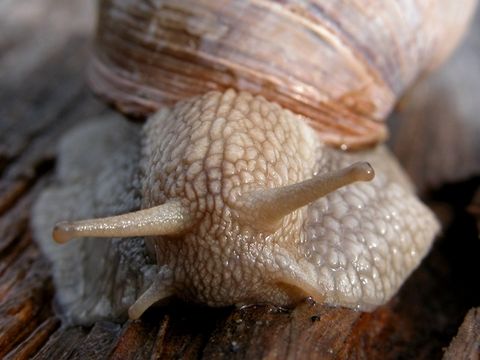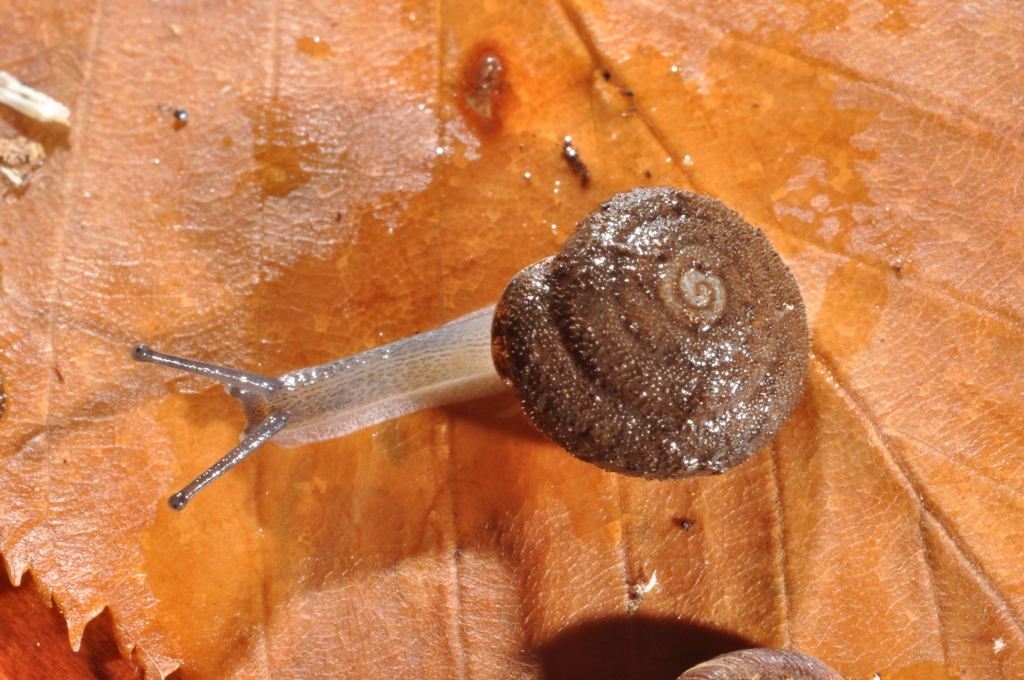Adaptation
Did you know snails can carry up to ten times their own body weight? (Bourquin, 2000).
Inflectarius edentatus is an air-breathing, terrestrial snail
living throughout parts of North America. Like any
other organism, Inflectarius edentatus contain numerous
morphological and physiological adaptations, ranging from those
of structural, respiratory and sensory adaptations. However,
with little research known about the specific evolutionary
alterations I. edentatus has undergone, much of the
following adaptations listed below are integrated within
Gastropoda, the class containing Inflectarius edentatus, as
well as Pulmonata, the subclass containing Inflectarius edentatus.

One of the most noticeable adaptations within the
Class Gastropoda can be seen in the evolutionary change of the shell
structure. Once coiled in a single, flat plane, the shell was
symmetrical with each coil lying flat on top of the other
(Bourquin, 2000). This created problems for early
gastropods
because the symmetrical coils were not very condensed and the
diameters of some gastropods grew to be very large and heavy in
structure, making it difficult for locomotion purposes
(Bourquin, 2000). In order to solve this problem,
gastropods
experienced a significant change in structure with the 180
degree twisting of the shell called torsion (Bourquin, 2000).
The 180 degree twisting of the shell solved the issue of balance
and weight distribution by laying each coil around a central
axis, termed a columella, and shifting these coils on a spirally
upward slant. With the shell situated diagonally, the snails
could now move around with greater simplicity and speed
(Bourquin, 2000).
 As pulmonates, otherwise known as air-breathing land snails,
Inflectarius edentatus may also face the vast problem of
desiccation, or dehydration, especially in very dry and arid
conditions (What-when-how, 2012). Fortunately, pulmonates have
undergone multiple adaptations in order to avoid and protect
against desiccation, the first being the operculum (Bourquin,
2000). The operculum is a flat, outer protective structure that
is attached to the pulmonate’s shell, closing over the aperture
(Bourquin, 2000). It is described almost like a trap door that
snails pull over their opening in order to avoid dehydration or
harsh winter months (Bourquin, 2000). Another adaptation
aiding in the protection against desiccation is termed the epiphragm. In arid conditions, pulmonates retreat into their
shell and secrete the epiphragm (What-when-how, 2012). The epiphragm covering consists of either mucus or calcareous
materials (Thorp, 2009). Pulmonates also adapt to dehydration
and water loss through their excretory systems where they
transform nitrogenous wastes to uric acid (Klappenbach, 2012).
This uric acid is then released as solid crystals instead of a
liquid, water-bearing urine, therefore avoiding water loss
(Klappenbach, 2012).
As pulmonates, otherwise known as air-breathing land snails,
Inflectarius edentatus may also face the vast problem of
desiccation, or dehydration, especially in very dry and arid
conditions (What-when-how, 2012). Fortunately, pulmonates have
undergone multiple adaptations in order to avoid and protect
against desiccation, the first being the operculum (Bourquin,
2000). The operculum is a flat, outer protective structure that
is attached to the pulmonate’s shell, closing over the aperture
(Bourquin, 2000). It is described almost like a trap door that
snails pull over their opening in order to avoid dehydration or
harsh winter months (Bourquin, 2000). Another adaptation
aiding in the protection against desiccation is termed the epiphragm. In arid conditions, pulmonates retreat into their
shell and secrete the epiphragm (What-when-how, 2012). The epiphragm covering consists of either mucus or calcareous
materials (Thorp, 2009). Pulmonates also adapt to dehydration
and water loss through their excretory systems where they
transform nitrogenous wastes to uric acid (Klappenbach, 2012).
This uric acid is then released as solid crystals instead of a
liquid, water-bearing urine, therefore avoiding water loss
(Klappenbach, 2012).

Through the evolutionary time scale, Class Gastropoda evolved
into the Subclass Pulmonata, transforming their gills into
air-breathing lungs in order to prepare for a unique life on
land (Kerrie, 2010). The lung, located within the mantle
cavity of the snail, is highly vascularized, full of blood
vessels in order to take in oxygen through the lung tissues and
give up carbon dioxide (Bourquin, 2000). Respiration occurs when
the mantle cavity muscles tighten and flatten in order to
facilitate air flow in and out of the pneumostome or breathing
hole (Klappenbach, 2012).
Some aquatic snails were originally air-breathing pulmonates
that returned to a fresh-water environment later on in life
(Bourquin, 2000), therefore resulting in a few more respiratory
adaptations. While some pulmonates chose to move out of an
aquatic environment in order to obtain oxygen on land (Thorp et
al., 2010), others have adapted a long siphon structure that
allows snails to breathe atmospheric air underwater, as if it
were a snorkel (Bourquin, 2000). Others developed a reduced
mantle cavity in order to fit a secondary gill called a pseudobranch (Bourquin, 2000).
Pulmonates have also undergone a few sensory adaptations. Some
pulmonates have evolved a structure close to that of a gill,
called an osphradium (Bourquin, 2000). The evolution of the osphradium is not completely known by scientists, however it is
often thought of to function as a sensory organ in order to
identify and sense any minerals or sediments in the water that
would be passed over the gills (Bourquin, 2000). The osphradium
is often full of filaments or folded multiple times in order to
increase the surface area for this sensory function (Bourquin,
2000). Pulmonates have also evolved an additional pair of
tentacles (Bourquin, 2000). The first pair, often used for sight,
is longer than the second pair, which is often used for
chemoreception in snails (Bourquin, 2000). The second pair of
tentacles are also knobbed in order to increase surface area for
sensory purposes (Bourquin, 2000).

Now let's take a look into the nutrition of Inflectarius edentatus.
